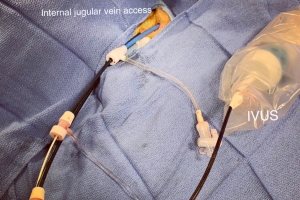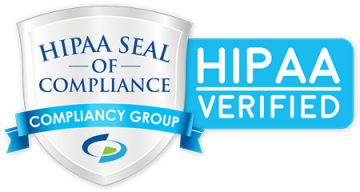Transjugular Intrahepatic Portosystemic Shunt (TIPS)
TIPS is an abbreviation for Transjugular Intrahepatic Portosystemic Shunt, a procedure that helps correct blood flow problems in the liver by connecting two blood vessels with an implanted device:
Transjugular through the jugular vein
Intrahepatic within the liver
Portosystemic from the portal vein to the general circulation
Shunt a channel for blood to flow
What is cirrhosis and portal hypertension?
The liver is the largest organ in the body, weighing about three pounds, and is responsible for over 500 functions. Most of the blood that leaves the stomach and the small intestines must pass through the liver. Cirrhosis of the liver occurs when normal liver tissue is damaged and replaced by scar tissue. Most of the blood flowing through the liver comes from the portal vein, and in a cirrhotic liver, the scar tissue significantly slows the flow of blood from the portal vein through the liver. This reduction of blood flow due to cirrhosis causes a large difference in the pressure of blood entering the liver and the pressure of blood exiting the liver to return to the heart. This difference in pressures is called portal hypertension.
Due to reduced blood flow through the liver, blood must now find a different way to reach the heart. The body diverts blood away from the liver by increasing blood flow through vessels surrounding the stomach and lower portion of the esophagus. This increased blood flow changes these vessels into swollen, twisted, and weak veins called varices. Varices can potentially rupture leading to bleeding which requires immediate medical attention. Another complication of portal hypertension is called ascites. Ascites is the accumulation of fluid in the peritoneal cavity which can cause abdominal swelling. Your doctor can provide you with additional information about these complications.
Treatment Options
For a person who has progressive or worsening liver cirrhosis and portal hypertension there are several treatment options available: 1. Your doctor may put you on medication in combination with a low salt and restricted protein diet. 2. You may require additional procedures to treat the complications of your liver cirrhosis such as: • Needle drainage of ascites fluid accumulating in your abdomen • Treatment of enlarged veins in your esophagus or stomach with banding or injections through a flexible scope 3. If the above treatments are ineffective, a TIPS procedure, open surgical interventions, or liver transplantation may be required
How does a TIPS help a person with portal hypertension?
A TIPS procedure creates a new channel to route blood flow through the damaged liver and into the main blood vessels that lead blood back to the heart. A TIPS stent placed inside this channel allows a portion of excess blood to bypass the liver, reducing portal hypertension and the associated complications.
What are the benefits of TIPS?
There are several benefits to having a TIPS procedure to correct blood flow problems in the liver and treat the consequences of portal hypertension such as ascites and varices. The TIPS procedure is a minimally invasive procedure which reduces recovery time and the time spent in the hospital. The TIPS procedure routes a portion of the excess blood flow through the liver and reduces the portal hypertension, so that alternative treatments such as medications, paracentesis for ascites, and the treatment of varices may be needed less frequently or not at all. Your doctor will provide more information regarding your TIPS treatment plan.
What happens during a TIPS procedure?
The TIPS procedure is accomplished through a minimally invasive procedure under general anesthesia and is performed by specially trained doctors (sometimes known as interventional radiologists) in the interventional radiology suite or occasionally the operating room of the hospital. You will not have anything to eat or drink for several hours before the procedure. During the TIPS procedure, you will be connected to monitors to track your heart rate and blood pressure. You will also have an intravenous line in your arm to administer medications during the procedure. An introducer sheath is placed through a small skin puncture in the jugular vein usually on the right side of the neck. The entire TIPS procedure is performed through this introducer sheath. The doctor will use X-ray pictures and X-ray dye (also called contrast dye) to guide the procedure. A long thin needle is next guided through the introducer sheath to the hepatic vein. Using X-ray guidance, the needle is directed from the hepatic vein into the portal vein creating a tunnel between the hepatic and portal veins. A special balloon is used to enlarge the liver tunnel and the doctor inserts the TIPS stent into the tunnel to help it remain open (Figure 1). When the procedure is finished, blood flow and pressures will be measured from the portal vein across the TIPS stent to the hepatic vein. At the completion of the procedure, only the TIPS stent will remain in your body. A TIPS procedure typically takes 2–3 hours to perform.
What are the risks of TIPS?
While all surgical procedures have risks, the risks associated with a TIPS procedure include:1 • Damage to blood vessels • Fever • Hepatic encephalopathy • Infection, bruising, or bleeding • Reactions to medicines or the dye • Stiffness, bruising, or soreness in the neck Rare risks are: • Bleeding in the belly • Blockage in the stent • Cutting of blood vessels in the liver • Heart problems or abnormal heart rhythms • Infection of the stent • Death Everyone is different, so there may be additional risks that are not mentioned here. The risks to each individual should be discussed in more detail with your doctor.
Following the TIPS procedure
The typical hospital stay after the TIPS procedure is one to three days or possibly longer. During that time, your doctor will monitor blood pressure and may conduct an ultrasound study of the liver and stent to make sure the device stays open. After going home, a diet low in protein and salt may be suggested. In addition, medications may be prescribed to minimize the accumulation of blood toxins. Contact your doctor immediately if you experience disorientation or confusion. It’s important that the TIPS is carefully monitored over the following three years. Advised follow-up may include check-ups at one month, six months, and each year after that. The follow-up exams may consist of routine X-rays, an ultrasound study and blood tests. Please ask your doctor if you have any questions regarding these tests and exams
How will I know if the TIPS is working?
The symptoms of portal hypertension that you have experienced may get better or go away. The swollen blood vessels may shrink and not be as prone to bleeding, which means you may not experience additional bleeding episodes. There may also be a reduction or complete resolution of the fluid that accumulates in the abdomen, which may reduce or eliminate the need for removing the fluid by paracentesis. Of course, if your symptoms get worse, you should contact your doctor immediately
For more information please see
American Liver Foundation www.liverfoundation.org
European Association for the Study of the Liver (EASL) www.easl.eu
Society of Interventional Radiology www.sirweb.org
US National Library of Medicine www.medlineplus.gov
US Department of Health and Human Services Food and Drug Administration www.fda.gov
W. L. Gore & Associates, Inc. www.goremedical.com
The above information is not all inclusive of the risks, alternatives and benefits. It is not meant to be a substitute for informed discussion between you and your doctor, but can act as a starting point for such a discussion. There are complications possible with any medical procedure. Overall, minimally invasive procedures have a lower complication rate than open surgeries.





